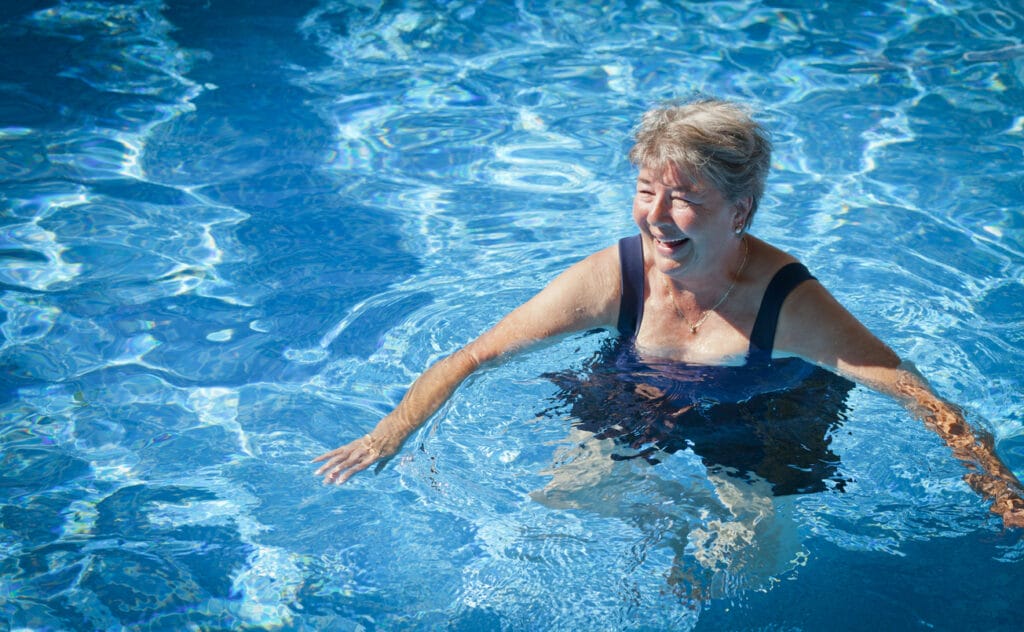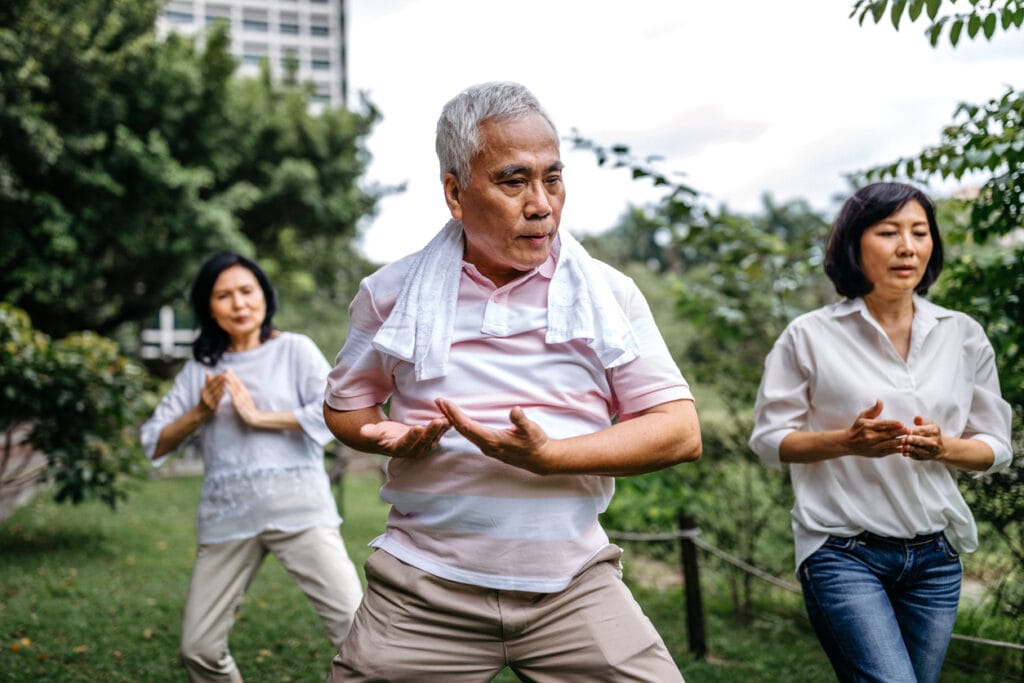Understanding the paramount importance of ensuring our seniors maintain optimal health and well-being, we recognize the significance of gentle yet effective ways to keep them active and engaged. This is where the concept of low-impact exercise shines brightly. Unlike high-intensity workouts that can strain aging bodies, low-impact exercises offer a gentler approach, minimizing stress while maximizing benefits. These activities cater to the physical needs of our seniors, fostering a sense of joy and accomplishment. From improved flexibility to stronger muscles, enhanced balance, and better cardiovascular health, the advantages are manifold. By introducing and encouraging such exercises, we empower our loved ones to lead fuller, healthier lives, enabling them to embrace each day with renewed vitality and vigor.
Walking
Walking emerges as an ideal low-impact exercise due to its accessibility for individuals across various fitness levels. Its simplicity and ease of execution make it an excellent choice for seniors seeking to engage in physical activity without undue strain on the body.
Benefits
- Improves Cardiovascular Health: Engaging in regular walking routines significantly enhances cardiovascular health by reducing the risk of heart disease, lowering blood pressure, and improving circulation, thus fostering a stronger and healthier heart.
- Strengthens Bones: The weight-bearing nature of walking promotes bone density, helping to prevent osteoporosis and fortify skeletal strength, which is essential for maintaining overall bone health and reducing the risk of fractures.
- Boosts Mood: Walking triggers the release of endorphins, the body's natural mood-boosting hormones, leading to reduced stress, anxiety, and depression levels. This uplifting effect contributes to improved mental well-being and overall quality of life.
Tips
- Explore Scenic Routes: Making walking more enjoyable can be achieved by exploring scenic routes that offer visual stimulation and a change of scenery, enhancing the overall experience and motivation to continue.
- Join Walking Groups: Consider joining walking groups or clubs to add a social element to the activity, fostering camaraderie, support, and motivation while providing opportunities for meaningful social interaction and connection.
Swimming

Swimming stands out as an advantageous form of exercise, primarily due to its inherent buoyancy, which significantly reduces strain on joints and muscles. The supportive properties of water create an environment where individuals can engage in physical activity with minimal impact, making it an ideal choice for those with joint pain or mobility issues.
Benefits
- Full-Body Workout: Swimming offers a comprehensive full-body workout, engaging multiple muscle groups simultaneously. The resistance provided by the water challenges muscles, leading to improved strength, endurance, and flexibility across the entire body.
- Low-Impact Exercise: Unlike high-impact activities such as running or weightlifting, swimming allows for intense workouts without subjecting the body to harsh impact. This makes it particularly suitable for individuals recovering from injuries or dealing with chronic conditions such as arthritis.
Tips
- Join Senior Swim Classes: Seniors may benefit from joining swim classes specifically tailored to their age group, where they can receive guidance from qualified instructors and socialize with peers who share similar fitness goals.
- Explore Water Aerobics: Water aerobics classes offer a dynamic and fun alternative to traditional swimming workouts. These classes often incorporate cardiovascular exercises, strength training, and flexibility exercises, providing a well-rounded fitness experience with the added benefits of social interaction and camaraderie.
Tai Chi

Tai Chi, a gentle martial art rooted in ancient Chinese tradition, is renowned for its slow, deliberate movements that flow seamlessly from one to the next. Its graceful motions emphasize balance, harmony, and inner calm, making it accessible to individuals of all ages and fitness levels.
Benefits
- Enhanced Balance: Compared to control groups, Tai Chi has been shown to have positive effects on balance, with a standardized mean difference (SMD) of 0.47, indicating a moderate improvement.
- Improved Flexibility and Strength: Through its gentle stretching and weight-shifting exercises, Tai Chi increases flexibility and strengthens muscles, leading to improved mobility and overall physical function.
- Reduced Fall Risk: Tai Chi's focus on body awareness and coordination helps seniors develop better control over their movements, decreasing the likelihood of falls and related injuries.
- Mental Health Benefits: Tai Chi's meditative nature encourages mindfulness and relaxation, reducing stress and anxiety while promoting mental clarity and emotional well-being.
Tips
- Look for Beginner Classes: Seniors interested in Tai Chi should seek out beginner classes tailored to their needs and abilities. These classes often focus on basic movements and provide a supportive environment for learning and practice.
- Utilize Instructional Videos: For those unable to attend classes in person, instructional videos specifically designed for older adults can be a valuable resource. These videos offer step-by-step guidance and demonstrations, allowing seniors to practice Tai Chi at their own pace in the comfort of their homes.
Stationary Cycling

Stationary cycling offers an excellent cardiovascular workout without the impact on joints associated with outdoor cycling. Its stationary nature provides stability and safety, making it an ideal choice for seniors looking to improve their fitness levels without risking injury.
Benefits
- Builds Leg Strength: Stationary cycling targets the lower body muscles, including the quadriceps, hamstrings, and calves, helping to build strength and endurance in these muscle groups.
- Improves Joint Mobility: The smooth, repetitive motion of cycling promotes joint mobility and flexibility, particularly in the hips, knees, and ankles, making it beneficial for seniors dealing with arthritis or stiffness.
- Increases Stamina: Regular cycling sessions enhance cardiovascular fitness and stamina, leading to improved endurance and overall physical capacity, which is essential for maintaining independence and quality of life.
- Improved Heart Health: Studies show regular cycling can significantly improve cardiovascular health, reducing the risk of heart disease by up to 50%.
Tips
- Vary Resistance Levels: To keep the exercise challenging and engaging, encourage seniors to experiment with different resistance levels on the stationary bike. Adjusting the resistance provides a way to progressively challenge the muscles and improve strength over time.
- Participate in Virtual Classes: Seniors may find motivation and structure by participating in virtual cycling classes or following along with pre-recorded workouts. These classes offer guidance, music, and a sense of community, making the exercise experience more enjoyable and rewarding.
Yoga
Yoga is a mindful practice that combines a series of poses, known as asanas, with controlled breathing exercises, or pranayama. This harmonious blend of movement and breath work promotes balance, flexibility, and inner peace, making it a comprehensive practice for enhancing overall health and vitality of our senior loved ones.
Benefits
- Improves Flexibility: Through gentle stretching and holding of poses, yoga gradually increases flexibility in muscles and joints, reducing stiffness and enhancing range of motion.
- Strengthens Muscles: Many yoga poses require engaging and holding specific muscle groups, leading to improved strength and endurance, particularly in the core, arms, and legs.
- Enhances Balance: Yoga's focus on stability and alignment helps seniors improve their balance and coordination, reducing the risk of falls and enhancing confidence in daily activities.
- Reduces Stress: The combination of mindful movement and deep breathing in yoga promotes relaxation, reduces stress levels, and fosters a sense of inner calm and tranquility.
Tips
- Start with Senior-Friendly Classes: Seniors may benefit from starting with yoga classes specifically designed for their age group. These classes often incorporate modifications and props to accommodate varying abilities and limitations, providing a safe and supportive environment for practice.
- Explore Gentle Yoga: Gentle yoga styles, such as Hatha or Restorative yoga, prioritize slow-paced movements and relaxation, making them well-suited for seniors or those with physical limitations. Focus on poses that emphasize stability, balance, and gentle stretching to promote overall well-being and comfort.
“Yoga is the settling of the mind into silence. When the mind has settled, we are established in our essential nature, which is unbounded Consciousness. Our essential nature is usually overshadowed by the activity of the mind.”
Special Considerations:
It's crucial to prioritize safety and well-being when embarking on any new exercise regimen, particularly for seniors or individuals with preexisting health conditions. Consulting with a healthcare provider before starting a new exercise program is essential to ensure compatibility with existing medical conditions and to receive personalized guidance. Here are some tips to consider:
- Consult with Healthcare Provider: We always encourage our loved ones to consult with their healthcare provider before starting any new exercise program. Healthcare professionals can offer valuable insights and personalized recommendations, considering individual health concerns and limitations.
- Start Slowly and Gradually: We understand the importance of starting with low-intensity activities and gradually increasing duration and intensity over time. By easing into exercise routines, our loved ones can build strength and endurance while minimizing the risk of injury or strain.
Equipment and Safety

Ensuring the right equipment and creating a safe exercise environment are essential elements of promoting a positive exercise experience. Here are some equipment suggestions and safety considerations that we prioritize for our loved ones:
- Walking: We make sure our loved ones have supportive and comfortable footwear with good arch support and cushioning to protect their feet and ankles. We encourage walking on even surfaces to reduce the risk of tripping or falling.
- Swimming: We provide our loved ones with goggles to protect their eyes and enhance visibility while swimming. Additionally, we ensure they have a well-fitted swimsuit and swim cap for comfort and ease of movement in the water.
- Yoga: We invest in high-quality yoga mats to provide cushioning and stability during yoga practice, reducing the risk of slips and falls. We also create a safe practice space free from obstacles and hazards.
- Cycling: We ensure our loved ones have a comfortable bike seat that provides adequate support and reduces pressure on sensitive areas. We also prioritize safety by ensuring they wear appropriate clothing, including padded cycling shorts and a helmet, for protection during rides.
Creating a safe exercise environment involves removing potential hazards, such as clutter or uneven surfaces, and ensuring proper hydration and warm-up routines. As family caregivers, we strive to create supportive and nurturing environments that encourage our loved ones to prioritize their health and well-being through exercise.
Key Takeawes
In conclusion, low-impact exercises offer a multitude of benefits for seniors, promoting physical health, mental well-being, and overall quality of life. From improved cardiovascular health to enhanced flexibility and reduced risk of falls, these activities empower seniors to lead active and fulfilling lives. By making low-impact exercises a regular part of their lifestyle, seniors can enjoy long-lasting benefits and maintain independence as they age. Remember, finding enjoyment in exercise is key to sustaining a long-term routine, so we encourage seniors to explore different activities and discover what brings them joy and fulfillment.





